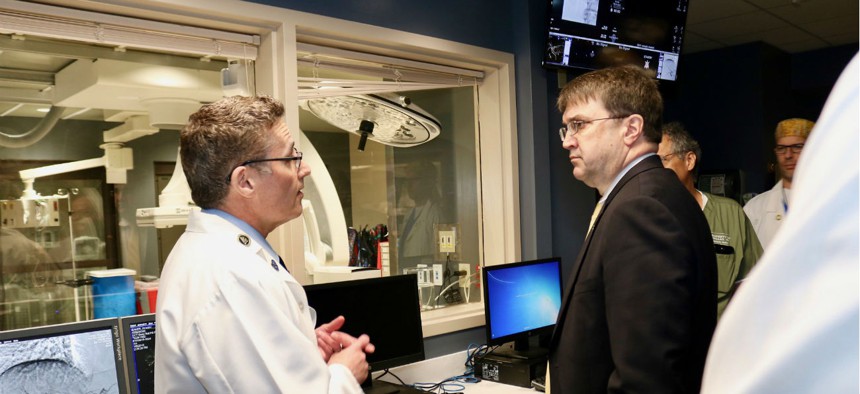
Veterans Affairs Secretary Robert Wilkie, right, tours a medical facility in August 2018. VA photo
How Well Do VA’s Regional Offices Perform? VA Doesn’t Really Know.
The department has 1,000 employees to oversee medical centers, but their roles have never been clearly defined and performance is not clearly measured, auditors say.
The Veterans Affairs Department has never clearly defined the role of its regional offices that oversee its 1,200 medical facilities, according to a new audit, and does not provide adequate supervision to ensure those offices perform well.
VA lacks a comprehensive strategy for the regional offices, known as Veteran Integrated Service Networks, and does not properly monitor staffing levels within them, the Government Accountability Office found in its report. Absent proper oversight, GAO said, department leaders have limited insight as to whether the regional offices are effectively ensuring that medical facilities around the country provide quality health care.
The department maintains a network of 18 regions, a system established in 1995 to decentralize the health care decisions made within the department. The regional offices have a combined workforce of around 1,000 employees. They set big-picture business and financial strategy through biannual site visits to medical facilities, conference calls, facility performance reviews and by coordinating the use of best practices.
VA has never clearly defined the role of the regional entities, however, such as what each is expected to do to oversee medical centers. GAO said that despite some guidance provided to the network directors, VA maintains no policy that enables it to deal with poorly performing regions.
The auditors found the Veterans Health Administration, which oversees the regional offices, relied primarily on the annual performance assessments of each region’s director to assess the overall performance of each Veteran Integrated Service Network. While VHA officials review specific topics quarterly, GAO said those efforts did “not provide comprehensive information on VISN-wide operations or overall performance of VISNs.”
Basing the evaluation of a large organization on the performance of its director could obscure information that the region “has failed to meet its objectives,” the auditors said. They noted that none of the metrics upon which VISN directors are evaluated focus on anything specific to the regional oversight of its medical facilities. When VHA officials meet with VISN staff, they use generic templates to make evaluations that do not provide specific information about the medical centers in that region.
“It is important for an organization to have both individual and organizational-level performance measures to help monitor performance,” GAO said.
VHA has established a standard organization chart for each region, which includes 63 to 66 positions and 28 key roles. It does not verify that each VISN actually matches the required structure, said GAO, which found that many regions failed to fill some of the key positions. The central office does not have a process for granting flexibility to a VISN.
GAO recommended the Veterans Health Administration more routinely review VISN staffing and develop a better strategy for assessing their overall performance.
“By establishing a process for assessing the overall performance of VISNs in managing and overseeing medical centers, VHA would be better able to determine if a VISN’s performance is positive, if it is functioning poorly, or if it requires remediation,” the auditors said.
VHA agreed with those two recommendations, but said a third—suggesting the department better define the role of VISNs—is already being addressed under existing plans. GAO took issue with that response, noting those plans would still not result in a comprehensive policy.







